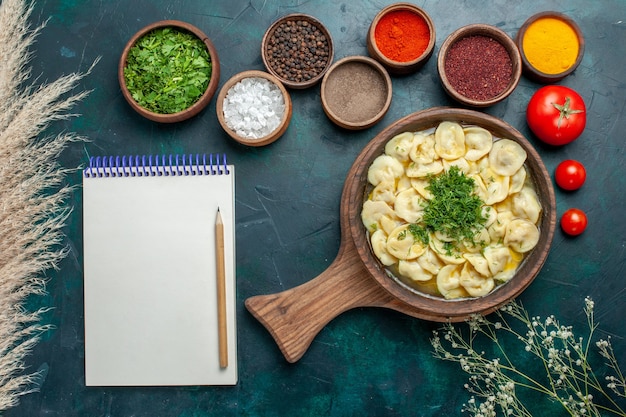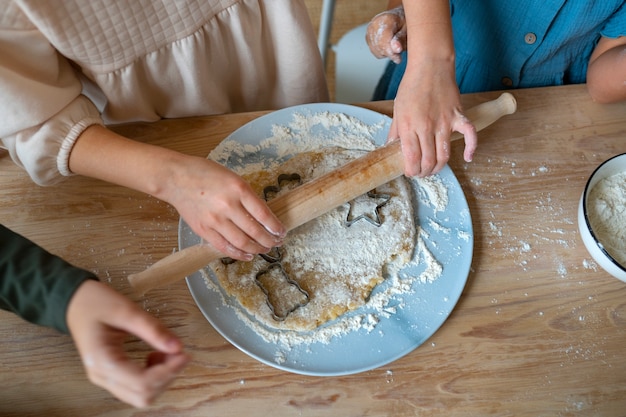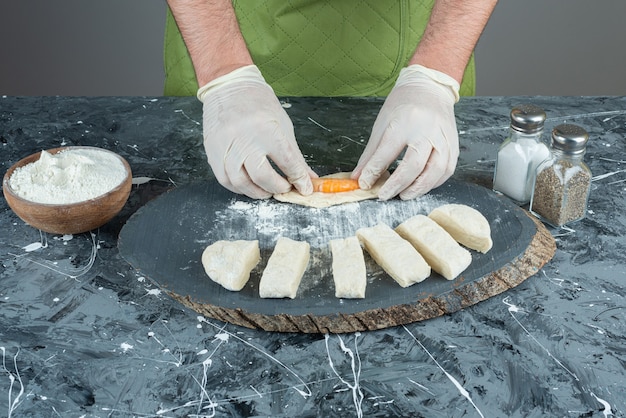Let's talk pierogi, those little bundles of joy that can transport you straight to a cozy kitchen in Poland. You know what I'm talking about, those plump, pillowy dumplings filled with all sorts of deliciousness. They're the ultimate comfort food, perfect for a chilly evening or a hearty family meal. And the best part? Making them is actually pretty straightforward, even for a novice like me. I've been making pierogi for years, and they've become a family favorite. Every time I whip up a batch, there's a queue forming around the kitchen counter! So, buckle up, grab your aprons, and let's embark on this delicious adventure together.
(Part 1) The Dough: The Foundation of Your Pierogi Perfection

The secret to perfect pierogi lies in the dough. It's the canvas that cradles all the wonderful fillings. So, let's start with the basics, shall we?
1.1. The Ingredients
You'll need these ingredients to make a batch of your very own pierogi dough:
- 2 cups all-purpose flour, plus more for dusting
- 1 teaspoon salt
- 1 egg
- 1 cup warm water
Now, here's a little tip from my years of pierogi-making: always use warm water, not too hot, not too cold. You want it to be just slightly lukewarm, like a warm bath on a chilly day. Trust me, it makes all the difference! The warm water helps to activate the gluten in the flour, which gives the dough its elasticity and helps it hold its shape during cooking.
1.2. The Mixing Process
Alright, get your mixing bowl ready. This is where the fun begins. Start by whisking together the flour and salt in the bowl. You want to create a little crater in the centre, like a miniature volcano. Now, crack that egg into the crater. This will help the dough to come together more evenly.
Next, slowly pour in the warm water, one cup at a time. Using your hands, gently bring the flour mixture together, incorporating it into the egg and water. You're aiming for a smooth and pliable dough. If it seems a bit dry, add a tablespoon or two of water, but don't overdo it.
Now, it's time to knead. Dust your countertop with flour and transfer the dough onto it. Get your hands in there and start kneading for about 5-7 minutes. You want the dough to be smooth, elastic, and no longer sticky. It should feel nice and firm under your fingers. Think of it like a good workout for your dough – it'll make for a better pierogi experience in the end. Kneading develops the gluten in the dough, which gives it structure and helps it to hold its shape during cooking.
1.3. The Resting Time
Once you've worked your dough into a beautiful, smooth ball, it's time for a little rest. Cover the dough with a clean kitchen towel and let it sit for about 30 minutes at room temperature. This gives the gluten in the dough a chance to relax and become more pliable. It's like giving the dough a chance to catch its breath after all that kneading. The resting time allows the gluten strands to relax, making the dough easier to roll out and less likely to tear or shrink during cooking.
(Part 2) The Fillings: The Soul of Your Pierogi

Now we're getting to the fun part – the fillings! This is where you can really get creative. Pierogi fillings are as diverse as the people who make them. I love experimenting with different flavours, but here are a few classic and crowd-pleasing options to get you started.
2.1. Classic Potato and Cheese
This is a true pierogi staple. It's simple, comforting, and always a winner. To make this filling, you'll need:
- 2 cups cooked potatoes, mashed
- 1/2 cup ricotta cheese
- 1/2 cup cheddar cheese, grated
- 1 small onion, finely chopped
- Salt and pepper to taste
Combine all the ingredients in a bowl and mix well. You want the filling to be moist but not too runny. Now, add a touch of your personal magic. I like to add a pinch of paprika for a hint of smoky flavour. Feel free to experiment with different herbs and spices to create your own signature blend. You can also add a bit of sour cream to the filling for a richer, creamier texture.
2.2. Savoury Sauerkraut
For those who enjoy a bit of tanginess, sauerkraut filling is a must-try. This is a classic Polish flavour that's both comforting and satisfying.
- 1 cup sauerkraut, rinsed and squeezed dry
- 1 small onion, finely chopped
- 1 tablespoon butter
- Salt and pepper to taste
Melt the butter in a pan over medium heat. Add the onion and cook until translucent, about 5 minutes. Now, add the sauerkraut and cook for another 5-7 minutes, stirring occasionally. Season with salt and pepper to taste. Let it cool slightly before filling your pierogi. For a richer flavour, you can add some caraway seeds to the sauerkraut while it's cooking.
2.3. Creamy Mushroom
This filling is a vegetarian dream. It's packed with flavour and incredibly satisfying.
- 1 pound mushrooms, sliced
- 1 tablespoon olive oil
- 1 small onion, finely chopped
- 2 cloves garlic, minced
- 1/2 cup vegetable broth
- 1/2 cup sour cream
- Salt and pepper to taste
Heat the olive oil in a pan over medium heat. Add the onion and garlic and cook until softened, about 5 minutes. Then add the mushrooms and cook until they're tender and browned, about 10-15 minutes. Stir in the vegetable broth and simmer for a few minutes until it reduces slightly. Finally, stir in the sour cream and season with salt and pepper to taste. This filling is best served warm, so make sure to keep it hot while you're assembling your pierogi. You can also add a splash of white wine to the mushroom mixture for a more complex flavour.
2.4. Sweet and Savoury Options
Beyond the classic savoury fillings, there are also some delicious sweet and savoury options to explore. Imagine a pierogi filled with sweet blueberry jam, or a decadent cherry filling. These are perfect for those who like a bit of sweetness in their dumplings. You can also create a sweet cheese filling by combining ricotta cheese with sugar and lemon zest.
(Part 3) Shaping the Pierogi: A Balancing Act

Okay, now that you've got your dough and filling ready, it's time to get those hands busy. Shaping the pierogi is a crucial step. It's all about creating those perfect little pockets of flavour.
3.1. Rolling Out the Dough
Start by dividing your dough into 12 equal pieces. Dust your countertop with flour and roll out each piece of dough into a thin circle, about 4-5 inches in diameter. Remember to keep the dough dusted with flour so it doesn't stick to your rolling pin or countertop. A tip from my grandmother: use a rolling pin that has a little extra heft. It makes rolling out the dough easier and gives you a smoother texture.
3.2. Filling and Folding
Now, it's time to get creative. Place a generous tablespoon of filling in the centre of each dough circle. Don't overload it. You want to make sure there's enough dough to seal properly.
Here's where things get interesting. You've got options for folding your pierogi. There's the traditional half-moon shape, where you fold the dough over in half and crimp the edges. Then there's the crescent shape, where you fold the dough over into a crescent and pinch the edges together. And for something a little different, you can even try a square shape.
Whichever way you choose to fold them, make sure the edges are well-sealed. No one wants their filling to leak out during cooking! You can use a fork, a pierogi tool, or even your fingers to create a neat and secure seal.
(Part 4) Cooking the Pierogi: From Raw to Ready
The moment of truth has arrived. It's time to cook those beautiful little pierogi and bring them to life.
4.1. Boiling
The most common way to cook pierogi is by boiling them. Fill a large pot with water and bring it to a boil over high heat. Add a tablespoon of salt to the boiling water. This helps to season the pierogi and prevents them from sticking together.
Carefully drop your pierogi into the boiling water, making sure they don't overcrowd the pot. Reduce the heat to medium and cook for 5-7 minutes. You know they're ready when they float to the surface. Once they're done, remove them from the pot with a slotted spoon and set them aside. If you're planning on frying or baking the pierogi after boiling, you can drain them in a colander to remove excess water.
4.2. Frying
For a crispy texture, you can also fry your pierogi after boiling them. Heat a tablespoon of butter or oil in a skillet over medium heat. Add the boiled pierogi to the skillet and cook for 2-3 minutes per side, or until golden brown and crispy. Frying the pierogi adds a delicious crunch to the outside while keeping the filling moist and flavorful.
4.3. Baking
If you prefer a more oven-friendly approach, you can bake your pierogi. Arrange the boiled pierogi in a baking dish and brush them with melted butter or oil. Bake in a preheated oven at 350°F (175°C) for 15-20 minutes, or until they're golden brown and heated through. Baking is a good option if you want to cook a large batch of pierogi and keep them warm in the oven until you're ready to serve them.
(Part 5) Serving Suggestions: A Feast for the Senses
You've made it this far, and now it's time to celebrate! Serving your pierogi is an art form in itself. It's all about bringing together the right flavours and textures to create a culinary masterpiece.
5.1. The Classic Approach
Traditionally, pierogi are served with a dollop of sour cream or a sprinkle of fried onions. The tangy sour cream balances out the rich fillings, while the caramelized onions add a touch of sweetness and depth of flavour.
5.2. Beyond the Basics
But let's face it, you don't have to stick to the traditional ways. Feel free to get creative with your toppings and sides. Imagine serving your pierogi with a medley of sauteed mushrooms and spinach, or a drizzle of melted garlic butter. You can even create a delicious tomato-based sauce for a more Italian twist. The possibilities are endless! Here are a few more ideas:
- A dollop of horseradish sauce for a spicy kick
- A sprinkle of crumbled bacon for extra saltiness
- A drizzle of melted cheese for a creamy topping
- A side of sautéed cabbage with bacon for a hearty meal
- A simple salad for a lighter option
(Part 6) Storing and Reheating: Keeping the Goodness Alive
You've made a big batch of pierogi, and you're not going to eat them all in one sitting. What are you going to do with the rest? Don't worry, I've got you covered.
6.1. Storage
To keep your pierogi fresh, store them in an airtight container in the refrigerator for up to 3-4 days. Make sure they're completely cooled before you store them. You can also freeze your pierogi for up to 3 months. To freeze them, arrange them in a single layer on a baking sheet and freeze them for about 30 minutes. Once they're frozen solid, you can transfer them to a freezer-safe bag. To reheat frozen pierogi, simply drop them into boiling water for 5-7 minutes until they're heated through.
6.2. Reheating
To reheat leftover pierogi, you can boil them again in water, pan-fry them with a little bit of oil, or bake them in the oven. The best method depends on your preference and how much time you have. But no matter how you choose to reheat them, try to keep them moist and warm. A good splash of water or a little bit of butter will help to prevent them from drying out.
(Part 7) Variations on the Theme: Beyond the Basics
You've mastered the basics of pierogi making, but the fun doesn't stop there. There are endless possibilities for adding your own personal flair to these delicious dumplings.
7.1. Dough Variations
You can experiment with different flours, like whole wheat or spelt, for a more rustic and nutty flavour. You can also add herbs or spices to the dough, like dill or paprika, to create a more complex flavour profile.
7.2. Filling Combinations
The beauty of pierogi is that you can fill them with anything you like. Try mixing and matching different cheese, vegetable, or meat fillings. You can also add fruits, like blueberries or cherries, for a sweet and savoury combination. Here are some more ideas:
- Cheese and Spinach
- Beef and Cabbage
- Chicken and Mushroom
- sweet potato and Pecan
- Apple and Cinnamon
7.3. Dipping Sauces
Don't forget about the dipping sauces. Go beyond the traditional sour cream and explore other options. Try a tangy salsa, a creamy pesto, or a spicy sriracha sauce. You can also make a quick and easy garlic butter sauce by melting butter in a saucepan and stirring in minced garlic and a pinch of salt.
(Part 8) Pierogi as a Symbol of Culture and Tradition
Pierogi aren't just a delicious dish – they're a symbol of Polish culture and tradition. They're a dish that brings people together, a reminder of family gatherings, and a testament to the power of simple, hearty food. Making pierogi is a way of connecting with your heritage, sharing your love of food with others, and creating memories that will last a lifetime. So, the next time you're looking for a fun and rewarding culinary adventure, give pierogi a try. You won't regret it!
FAQs
1. Can I use store-bought dough for pierogi?
Absolutely! While making the dough from scratch is certainly rewarding, there's no shame in using store-bought dough if you're pressed for time. It's a convenient alternative that still allows you to enjoy the deliciousness of homemade pierogi. Look for a good quality dough that's pliable and easy to work with.
2. How do I know if my dough is ready to roll?
A good dough will be smooth and elastic, not too sticky or dry. It should bounce back slightly when you poke it with your finger. If it's still a bit sticky, sprinkle a little more flour on your countertop and knead it for another minute or two.
3. How do I make sure the filling is cooked through?
The best way to ensure your filling is cooked through is to boil the pierogi until they float to the surface. This indicates that the filling has been exposed to the heat long enough to cook properly.
4. Can I freeze uncooked pierogi?
Yes! Freezing uncooked pierogi is a great way to make large batches and enjoy them later. Simply arrange the uncooked pierogi in a single layer on a baking sheet and freeze them for about 30 minutes. Once they're frozen solid, you can transfer them to a freezer-safe bag.
5. Can I use different fillings for pierogi?
Absolutely! Pierogi are incredibly versatile and can be filled with a wide array of ingredients. Get creative and experiment with different flavours to create your own signature pierogi dishes.
Now, go forth and make some magic in the kitchen! And remember, the most important ingredient is love. Have fun, embrace the process, and enjoy the delicious results.
Everyone is watching

How to Cook Frozen Lobster Tails Perfectly: A Step-by-Step Guide
RecipesLobster. Just the word conjures up images of lavish meals, special occasions, and a taste of luxury. But let's...

Pigs in a Blanket Cooking Time: How Long to Bake for Perfect Results
RecipesAh, pigs in a blanket. Just the name conjures up images of those delightful little parcels of crispy pastry en...

Pork Fillet Cooking Time: How Long to Cook It Perfectly
RecipesPork fillet, or tenderloin as it's sometimes called, is a real favourite in our house. It's so versatile, and...

The Ultimate Guide to Cooking Sweet Potatoes: From Roasting to Mashing
RecipesSweet potatoes. Just the name conjures up images of warm, comforting dishes, bursts of vibrant color, and a to...

The Ultimate Guide to Tender, Juicy Pulled Pork
RecipesRight, let's talk pulled pork. It's one of those dishes that just screams "comfort food," doesn't it? I mean...
